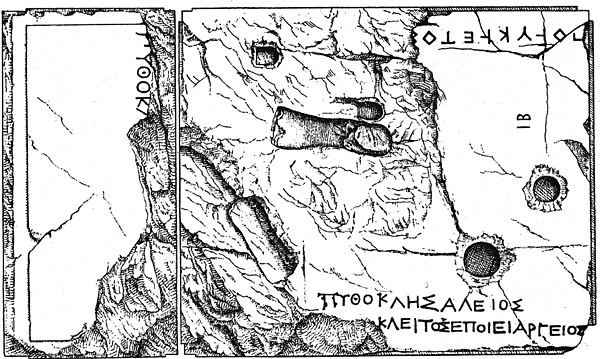
| CSAD Newsletter No. 9, Winter 2002 |
A so-called sculptor's signature is an inscription revealing who made a sculpture; most of the time this inscription was cut on the statue base, but sometimes it is written on the sculpture itself. Its language is usually simple: a name, sometimes a patronymic and an ethnic, followed by a verb.

IG i3 1380, base for the grave-stele of Lampito, with signature of the sculptor Endoios integrated into the funerary inscription, late 6th century BC
Beyond their laconicism, sculptors' signatures have always been a puzzle for art historians and epigraphists because of their exceptional character; most ancient statues were not signed. One is entitled to wonder why a sculptor's name was sometimes cut on a statue or on its base and who was interested in reading it.
The first sculptors' signatures appeared during the second part of the seventh century BC, and their use is not interrupted until at least the fourth century AD. We cannot expect that the same reasons will cause the same effects over such a long period. The fact that the "sculptor's signature" was initially very often integrated into an epigram, as in the case of the grave-stele for Lampito, IG i3 1380, illustrated above, and progressively, through the fifth and fourth century, detached itself and became an autonomous piece of information, as in I.v.Olympia 162 illustrated below, where the sculptor's signature is cut on the upper surface, while the identifying inscription is placed on the front face of the statue base, should constitute a first warning for chronological differentiation.

I v. Olympia 162-163: statue base for Pythokles with signature of the Argive sculptor Polykleitos, late 5th/early 4th century BC. The text was re-inscribed on the upper surface of the base in the late Hellenistic period
Overall there is a gap in our evidence. To my knowledge there is no clear literary evidence of someone actually reading and quoting a sculptor's signature before Philochoros and Herodas. Consequently for the previous periods, we are forced to use another kind of evidence, which I would like to call the "anti-sculptor's signature": Pindar, Nemean 5, composed in 487 or 489 BC. This poem starts in an extraordinary way with the words "I am not a sculptor". Pindar goes on comparing and opposing a statue, by its nature immobile, with his mobile poetry, which can be repeated and sung far away from its original place of composition. Scholars generally consider that Pindar was diminishing sculpture to the profit of poetry.
Apparently not everybody agreed with the great poet. On the contrary, Pindar's words themselves seem to imply that in some people's minds poet and sculptor were equally able to promote the glory of aristocratic athletes. The sculptor's signature would then be evidence for the sculptor's pretension to the role of medium between mortals and their immortal glory, in the same way as poets. This concept would have been shared by the patron who accepted the cutting and the public display of the inscription.
Aside from the content of the inscriptions, their display and their setting may also provide some information. Two kinds of comparison may be relevant:
1. A comparison between different ancient copies of the same signature under the same statue:
2. A comparison between different signatures by the same sculptor:
The two examples illustrated here, IG i3 1380 from Athens and I.v.Olympia 162-163 from Olympia, carrying signatures, respectively, by Endoios and Polykleitos, show that very different solutions could be adopted to display the same textual information. The physical appearance of an inscription could deeply modify its message. It was probably the result of a negotiation between sculptor and patron, whose results depended on cultural and social criteria and on the prestige of both parties. Each signature, or each group of signatures, requires a separate individual explanation which takes into account the different participants involved in the process of the inscription: the purchaser of the sculpture, the sculptor, potential later owners and readers. There is no univocal explanation for the phenomenon of signature and we must allow for a diversity of causes. By building an extensive database of this kind of document, which will take into account as much epigraphic as archaeological evidence, there is some hope of refining our picture of the artist's place in ancient society.
Alexis D'Hautcourt
Home | What's New | Events | Images | Links
| Created on |